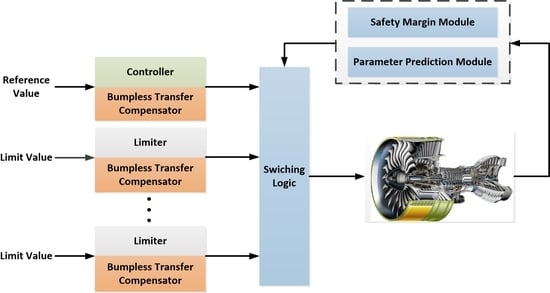An Output-Based Limit Protection Strategy for Turbofan Engine Propulsion Control with Output Constraints
Abstract
:1. Introduction
2. Output-Based Switching Logic of Multiple Control Loops
2.1. Multi-Loop Switching Control Strategy for Aero-Engines
2.2. Output-Based Multi-Loop Switching Control Strategy for Aero-Engines
2.2.1. Safety Margin Module
2.2.2. Parameter Prediction Module
2.2.3. Switching Logic
2.2.4. Mechanism Analysis of Output-Based Limit Management Method
3. Realization Principle of Bumpless Transfer Method
4. Design of Output-Based Aero-Engine Limit Management Method and Simulation Verification
4.1. Design of the Control Scheme for Aero-Engine Limit Management
4.2. Structural Transformation of the State Feedback Controllers
4.3. Aero-Engine Control Strategy for the Full Flight Envelope
4.3.1. Aero-Engine Linear Parameter Varying (LPV) Model
4.3.2. Control Plan Implementation Method Based on the Similarity Principle
4.4. Results and Discussion
4.4.1. Analysis of the Parameter Characteristics
4.4.2. Simulation Results and Discussion
5. Conclusions
Author Contributions
Funding
Conflicts of Interest
Appendix A
References
- Spang, H.A.; Brown, H. Control of jet engines. Control Eng. Pract. 1999, 7, 1043–1059. [Google Scholar]
- Richter, H.; Litt, J.S. A novel controller for gas turbine engines with aggressive limit management. In Proceedings of the 47th AIAA/ASME/SAE/ASEE Joint Propulsion Conference & Exhibit, San Diego, CA, USA, 31 July–3 August 2011. [Google Scholar]
- Richter, H. Advanced Control of Turbofan Engines; Springer: New York, NY, USA, 2012; pp. 140–228. [Google Scholar]
- Sun, J.; Vasilyev, V.; Ilyasov, B. Advanced Multivariable Control Systems of Aeroengines; Beihang Press: Beijing, China, 2005; pp. 60–83. [Google Scholar]
- Burcham, F.W.; Fullerton, C.G.; Maine, T.A. Manual Manipulation of Engine Throttles for Emergency Flight Control; NASA Reports; NASA: Washington, DC, USA, 2004.
- Richter, H. Control design with output constraints: Multi-regular sliding mode approach with override logic. In Proceedings of the 2012 American Control Conference (ACC), Montreal, QC, Canada, 27–29 June 2012. [Google Scholar]
- Richter, H. Multiple sliding modes with override logic: Limit management in aircraft engine controls. J. Guid. Control Dyn. 2012, 35, 1132–1142. [Google Scholar] [CrossRef]
- Du, X.; Richter, H.; Guo, Y. Multivariable Sliding-Mode Strategy with Output Constraints for Aero-engine Propulsion Control. J. Guid. Control Dyn. 2016, 39, 1631–1642. [Google Scholar] [CrossRef]
- Yu, B.; Ke, H.; Shu, W. A Novel Control Scheme for Aircraft Engine Based on Sliding Mode Control with Acceleration/Deceleration Limiter. IEEE Access 2019, 7, 3572–3580. [Google Scholar] [CrossRef]
- Yang, S.; Wang, X.; Yang, B. Adaptive sliding mode control for limit protection of aircraft engines. Chin. J. Aeronaut. 2018, 148, 78–86. [Google Scholar] [CrossRef]
- Qin, J.; Huang, J.; Pan, M. Optimal augmented monotonic tracking controller for aircraft engines with output constraints. Energies 2017, 10, 73. [Google Scholar] [CrossRef]
- Imani, A.; Montazeri-Gh, M. Improvement of Min-Max Limit Protection in Aircraft Engine Control: An LMI Approach. Aerosp. Sci. Technol. 2017, 68, 214–222. [Google Scholar] [CrossRef]
- Qin, J.; Pan, M.; Huang, J. A multi-regulator linear matrix inequalities approach for aircraft engines limit management. Int. J. Turbo Jet-Engines 2018. [Google Scholar] [CrossRef]
- May, R.D.; Garg, S. Reducing conservatism in aircraft engine response using conditionally active min-max limit regulators. In Proceedings of the ASME Turbo Expo: Turbine Technical Conference and Exposition, Copenhagen, Denmark, 11–15 June 2012. [Google Scholar]
- Richter, H. A multi-regulator sliding mode control strategy for output-constrained systems. Automatica 2011, 47, 2251–2259. [Google Scholar] [CrossRef] [Green Version]
- Imani, A.; Montazeri-Gh, M. A Multi-loop Switching Controller for Aircraft Gas Turbine Engine with Stability Proof. Int. J. Control Autom. Syst. 2019, 17, 1359–1368. [Google Scholar] [CrossRef]
- Seok, J.; Kolmanovsky, I.; Girard, A. Coordinated Model Predictive Control of Aircraft Gas Turbine Engine and Power System. J. Guid. Control Dyn. 2017, 40, 1–18. [Google Scholar] [CrossRef]
- Richter, H.; Singaraju, A.V.; Litt, J.S. Multiplexed Predictive Control of a Large Commercial Turbofan Engine. J. Guid. Control Dyn. 2008, 31, 273–281. [Google Scholar] [CrossRef] [Green Version]
- Peng, K.; Fan, D.; Yang, F. Active generalized predictive control of turbine tip clearance for aero-engines. Chin. J. Aeronaut. 2013, 26, 1147–1155. [Google Scholar] [CrossRef] [Green Version]
- Xu, W.; Pan, M.; Qin, J.; Huang, J. Reference and limit governors for limit protection of turbofan engines. Energies 2019, 12, 2803. [Google Scholar] [CrossRef]
- Hui, Y.; Mou, C.; Wu, Q.X. Flight envelope protection control based on reference governor method in high angle of attack maneuver. Math. Probl. Eng 2015, 2015, 254975. [Google Scholar]
- Kalabic, U.V.; Buckland, J.H.; Cooper, S.L.; Wait, S.K.; Kolmanovsky, I.V. Reference governors for enforcing compressor surge constraints. IEEE Trans. Control Syst. Technol. 2016, 24, 1729–1739. [Google Scholar] [CrossRef]
- Garone, E.; Di Cairano, S.; Kolmanovsky, I. Reference and command governors for systems with constraints: A survey on theory and applications. Automatica 2017, 75, 306–328. [Google Scholar] [CrossRef] [Green Version]
- Day, I. Stall, Surge and 75 Years of Research. J. Turbomach. 2016, 138, 011001. [Google Scholar] [CrossRef]
- Campo, P.J.; Morari, M.; Nett, C.N. Multivariable anti-windup bumpless transfer schemes. In Proceedings of the American Control Conference, Pittsburgh, PA, USA, 21–23 June 1989. [Google Scholar]
- Edwards, C.; Postlethwaite, I. Anti-windup and bumpless transfer schemes. Automatica 1998, 34, 199–210. [Google Scholar] [CrossRef]
- Lewis, F.L. Optimal Control; Wiley International: New York, NY, USA, 1986. [Google Scholar]
- Green, M.; Limebeer, D.J.N. Linear Robust Control; Pearson Education: London, UK, 1995; pp. 415–448. [Google Scholar]
- Hanus, R.; Kinnaert, M.; Henrotte, J.L. Conditioning technique, a general anti-windup and bumpless transfer method. Automatica 1987, 23, 729–739. [Google Scholar] [CrossRef]
- Hyde, R.A. The Application of Robust Control to VSTOL Aircraft. Ph.D. Thesis, University of Cambridge, Cambridge, UK, 1991. [Google Scholar]
- Turner, M.C.; Walker, D.J. Linear-quadratic bumpless transfer. Automatica 2000, 36, 1089–1101. [Google Scholar] [CrossRef]
- Turner, M.C.; Aouf, N.; Bates, D.G.; Postlethwaite, I.; Boulet, B. Switched control of a vertical/short take-off land aircraft: An application of linear-quadratic bumpless transfer. Proc. Inst. Mech. Eng. Part I J. Syst. Control Eng. 2006, 220, 157–170. [Google Scholar] [CrossRef]
- Kowalski, K.K.; Achterberg, J.; Lierop, C.M.M.V. Implementation of a Linear Quadratic Bumpless Transfer Method to a Magnetically Levitated Planar Actuator with Moving Magnets. In Proceedings of the IEEE International Conference on Control Applications, Yokohama, Japan, 8–10 September 2010. [Google Scholar]
- Shamma, J.S. Analysis and Design of Gain Scheduled Control Systems. Ph.D. Thesis, Massachusetts Institute of Technology, Cambridge, MA, USA, 1988. [Google Scholar]
- Lu, F.; Qian, J.; Huang, J. In-flight adaptive modeling using polynomial LPV approach for turbofan engine dynamic behavior. Aerosp. Sci. Technol. 2017, 64, 223–236. [Google Scholar] [CrossRef]
- Zhou, W.X. Research on Object-Oriented Modeling and Simulation for Aero-Engine and Control System. Ph.D. Thesis, Nanjing University of Aeronautics and Astronautics, Nanjing, China, 2007. [Google Scholar]



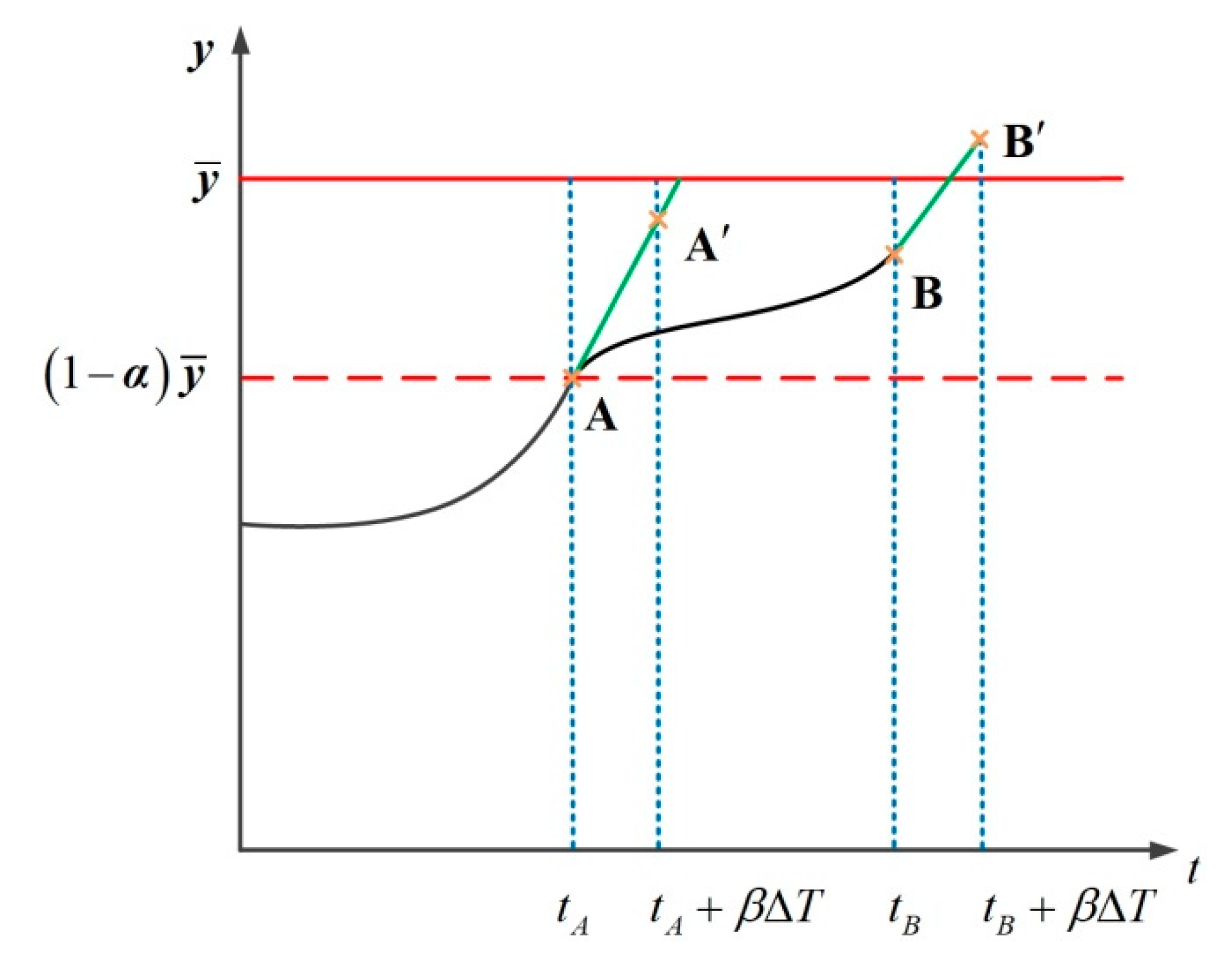

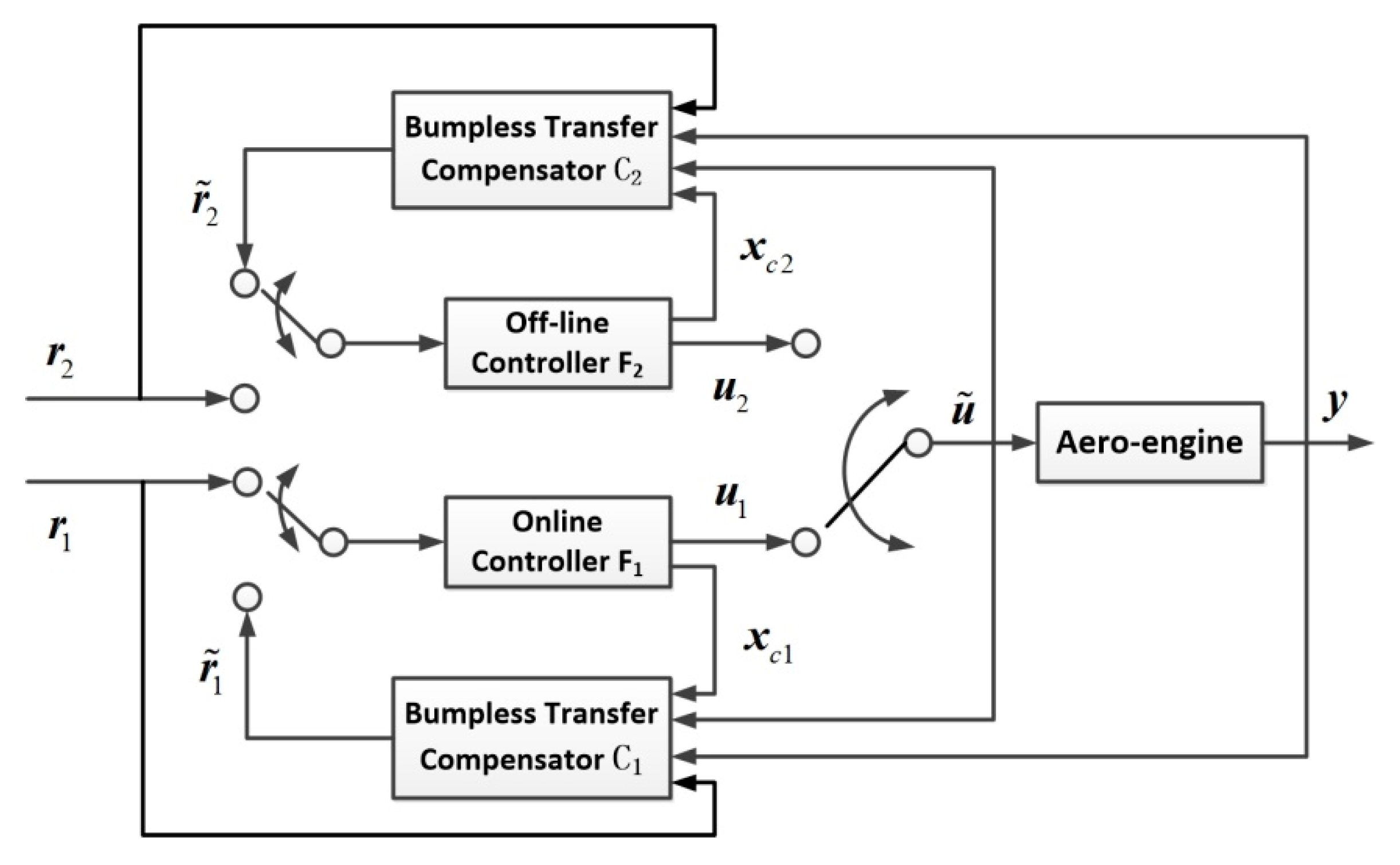
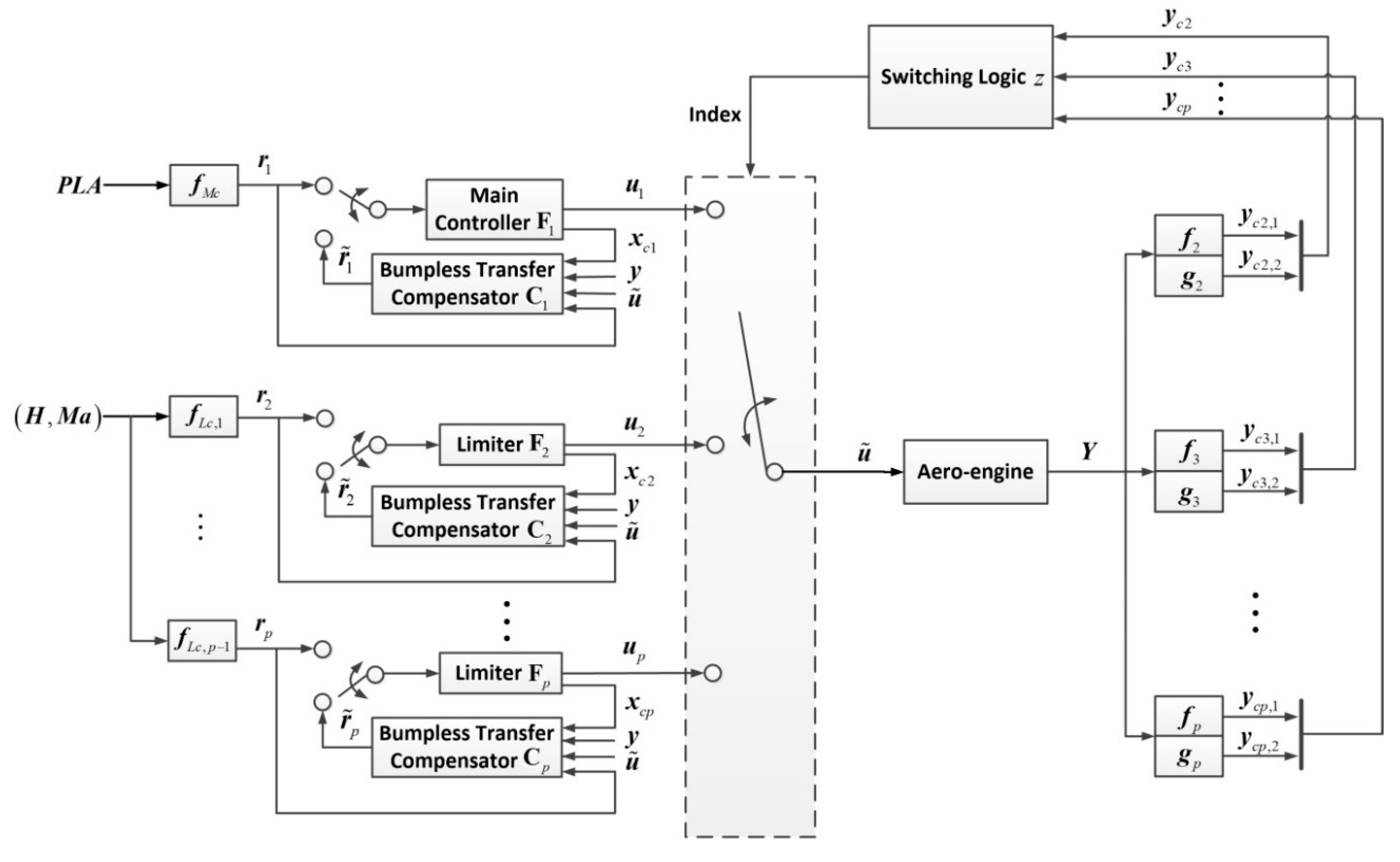

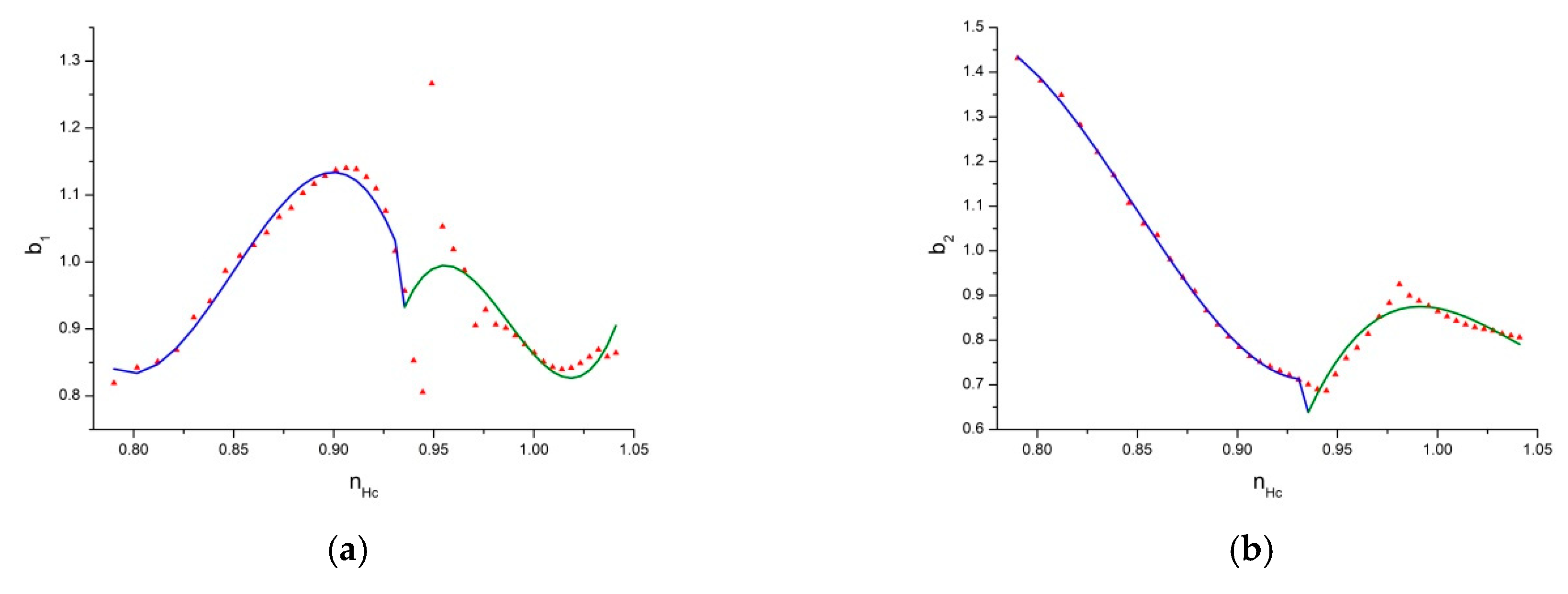


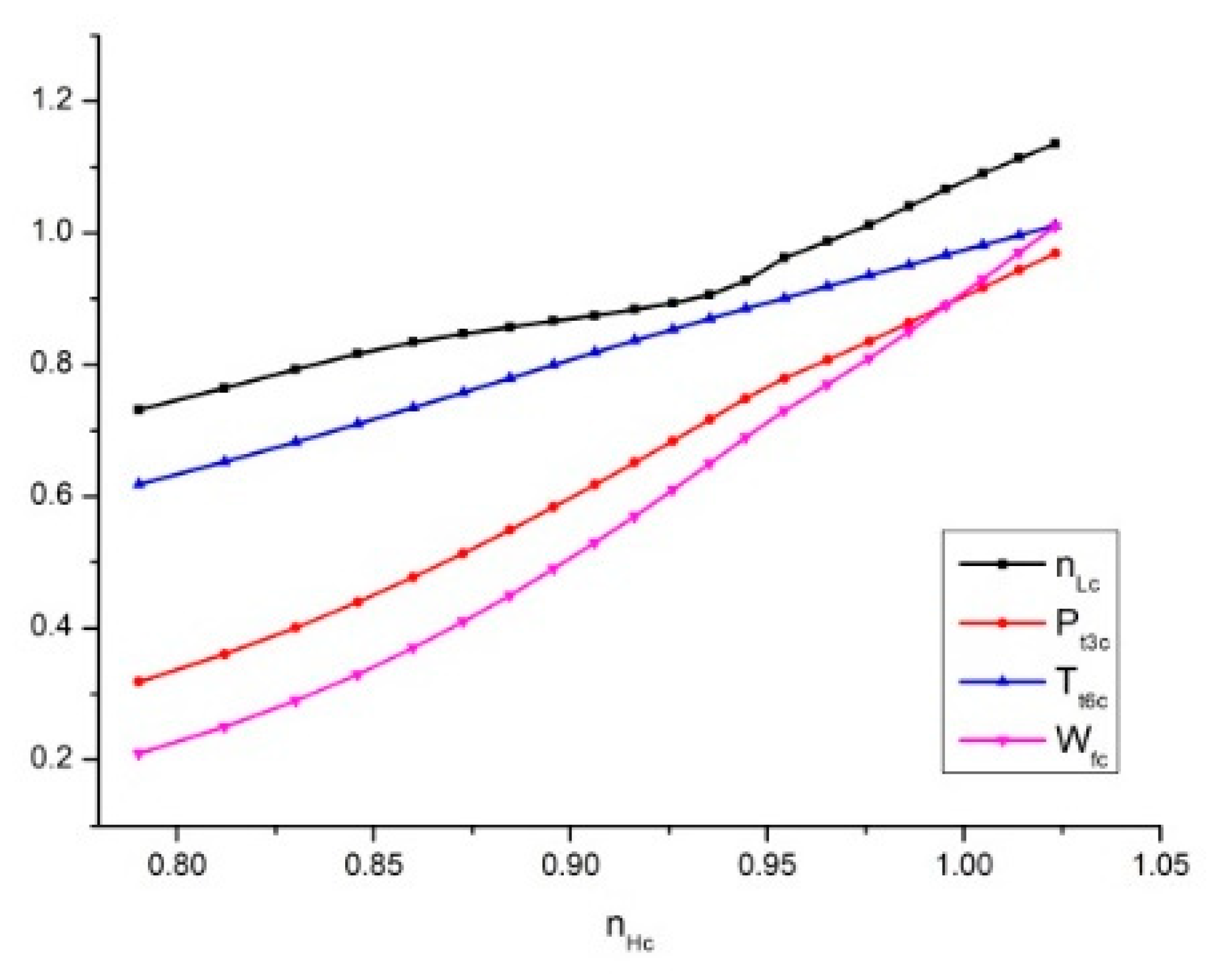

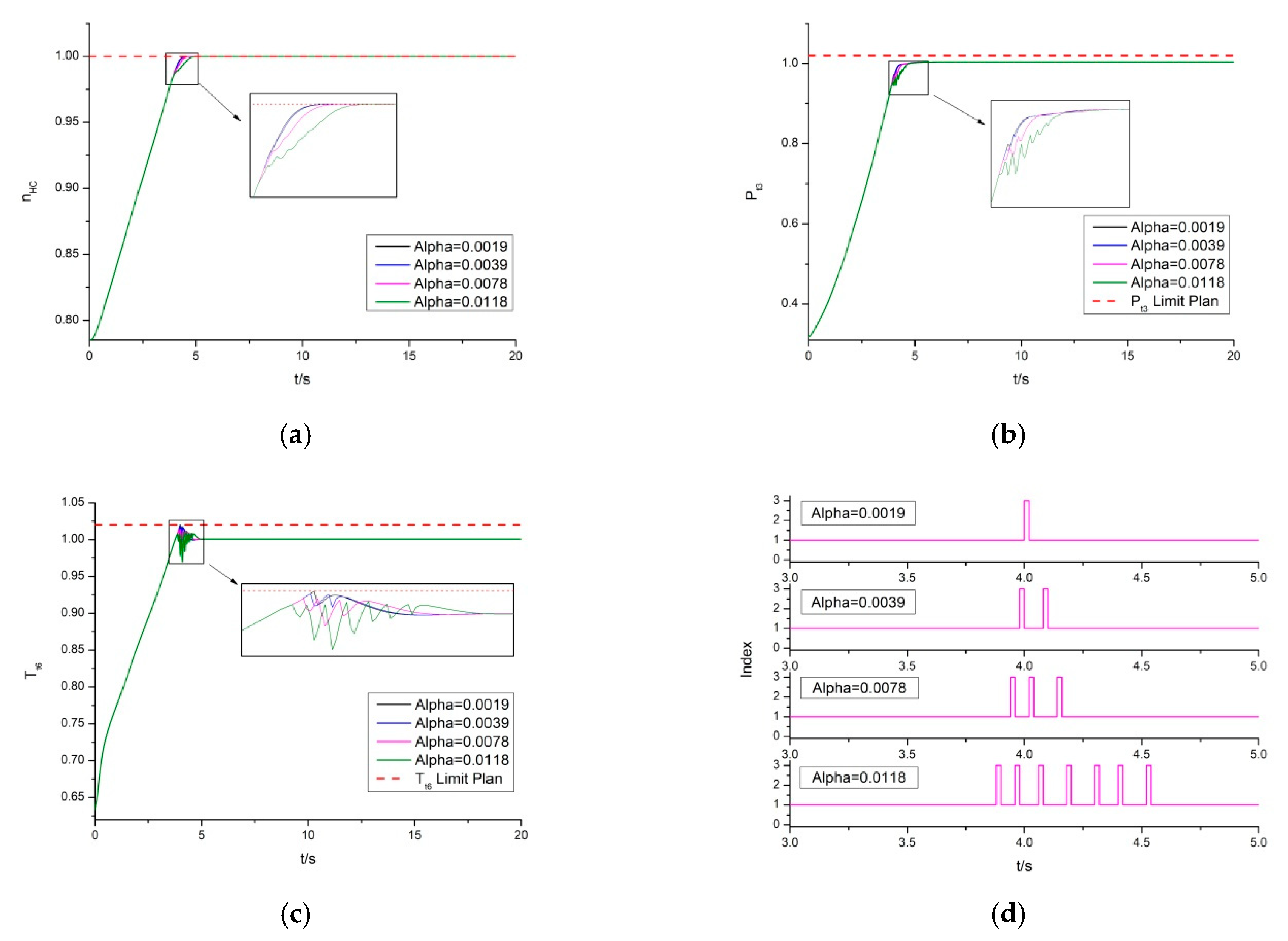

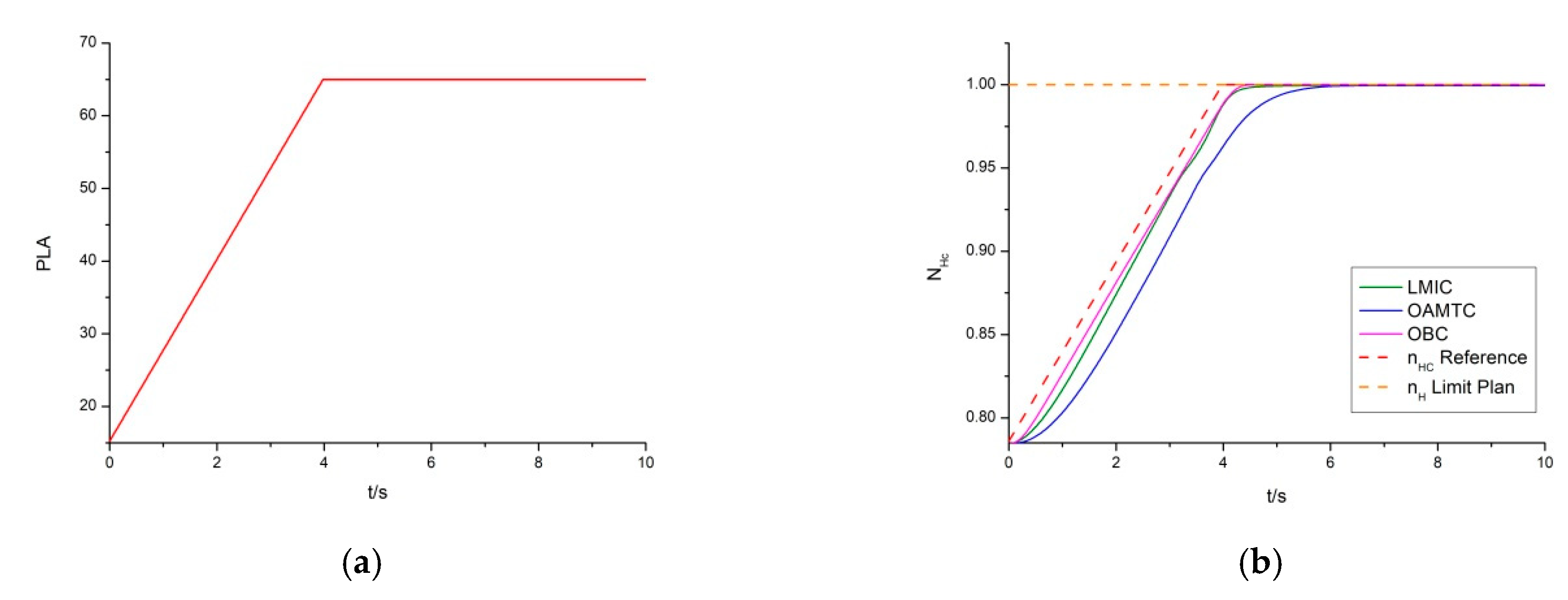



© 2019 by the authors. Licensee MDPI, Basel, Switzerland. This article is an open access article distributed under the terms and conditions of the Creative Commons Attribution (CC BY) license (http://creativecommons.org/licenses/by/4.0/).
Share and Cite
Qin, J.; Pan, M.; Xu, W.; Huang, J. An Output-Based Limit Protection Strategy for Turbofan Engine Propulsion Control with Output Constraints. Energies 2019, 12, 4043. https://doi.org/10.3390/en12214043
Qin J, Pan M, Xu W, Huang J. An Output-Based Limit Protection Strategy for Turbofan Engine Propulsion Control with Output Constraints. Energies. 2019; 12(21):4043. https://doi.org/10.3390/en12214043
Chicago/Turabian StyleQin, Jiakun, Muxuan Pan, Wenhao Xu, and Jinquan Huang. 2019. "An Output-Based Limit Protection Strategy for Turbofan Engine Propulsion Control with Output Constraints" Energies 12, no. 21: 4043. https://doi.org/10.3390/en12214043
APA StyleQin, J., Pan, M., Xu, W., & Huang, J. (2019). An Output-Based Limit Protection Strategy for Turbofan Engine Propulsion Control with Output Constraints. Energies, 12(21), 4043. https://doi.org/10.3390/en12214043




